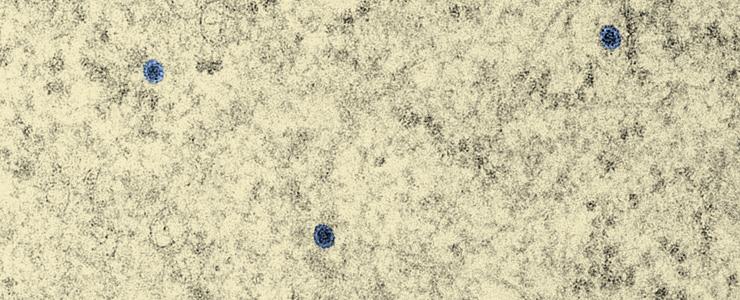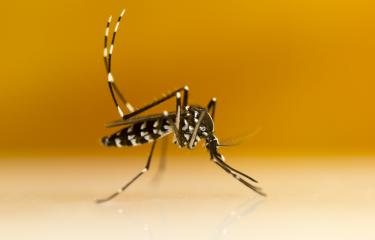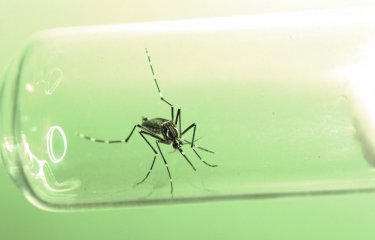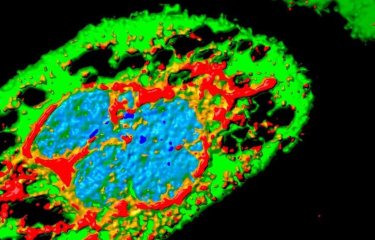Researchers at the Institut Pasteur have assessed the transmission potential of four populations of Aedes mosquitoes in circulation on the island of Madeira and southern France with a view to examining various possible scenarios for the introduction of Zika virus to Europe. Their work suggests that the Aedes aegypti mosquito present in Madeira is more likely to promote local transmission of Zika virus than Aedes albopictus. Consequently, it appears that the risk of a Zika epidemic in continental Europe is still low.

Green monkey cells infected with Zika virus seen through a transmission electron microscope. Viral particles measure 40nm in diameter. © Institut Pasteur
Zika is an arbovirus from the Flaviviridae family which is transmitted to humans by mosquitoes of the Aedes genus. It has caused a number of epidemic outbreaks in the South Pacific islands since 2007 and spread to Brazil in 2015. The virus is now present in over 34 countries in Latin America and the Caribbean affecting over 1.5 million people. There has also been a sharp increase in the number of cases imported from the Americas to Europe. The Aedes albopictus mosquito, which is present in 20 European countries and 30 departments of France, is due to become active in May when weather conditions allow it to thrive. Therefore the risk of local transmission of Zika virus to Europe is genuine and the question of how it might be introduced to the continent still needs to be addressed.
In Europe, Zika virus could be carried by Ae. albopictus and/or Ae. aegypti. Consequently, two virus introduction scenarios have been examined. The first relates to French departments in the Americas. People returning to France from these destinations may be a source of contamination for Ae. albopictus in southern France. In the second scenario, the starting point is the island of Madeira. It trades extensively with Brazil and Venezuela. The Ae. aegypti mosquito reported on the island since 2005 contributed to the dengue epidemic of 2012, which was the largest recent outbreak in Europe.
In order to test these two scenarios, researchers at the Institut Pasteur's Arboviruses and Insect Vectors Unit led by Anna-Bella Failloux worked with Portuguese researchers to assess the vector competence, or virus transmission potential, of four mosquito populations: two populations of Ae. aegypti from Madeira (Funchal and Paul do Mar) and two populations of Ae. albopictus from southern France (Nice and Bar-sur-Loup). The scientists infected female mosquitoes with Zika virus belonging to the Asian genotype equivalent to that currently circulating in Brazil.
The results show that Ae. aegypti transmits the virus more effectively than Ae. albopictus. In Ae. aegypti, the virus only takes 9 days to complete a full cycle and infect the insect's salivary glands, ready to be inoculated into a new host through a bite. In contrast, Ae. albopictus completes the same cycle in 14 days which significantly limits transmission.
It therefore appears that tiger mosquitoes in southern France and probably continental Europe are less capable of transmitting Zika virus locally which seems to support a hypothetical scenario whereby transmission is limited to regions in which Ae. aegypti is present, i.e. the island of Madeira. Other introduction scenarios should not be ruled out, especially via travelers returning from the Olympics this August. In any event, Europe should prioritize surveillance and monitoring of mosquitoes as soon as imported cases are detected.
Find out more
Read our Zika virus fact sheet.
Source
Zika virus, a new threat for Europe?
Henri Jupille1, Gonçalo Seixas2,3, Laurence Mousson1, Carla A. Sousa2,3, Anna-Bella Failloux1
1 Institut Pasteur, Arboviruses and Insect Vectors, Department of Virology, Paris, France
2 Instituto de Higiene e Medicina Tropical, Unidade de Parasitologia Médica, Universidade Nova de Lisboa, Portugal
3 Global Health and Tropical Medicine, Instituto de Higiene e Medicina Tropical, Universidade Nova de Lisboa, Portugal





